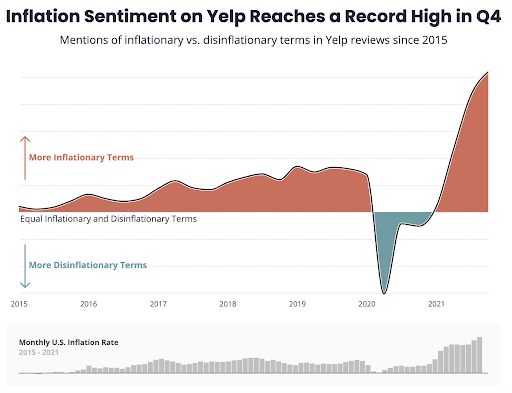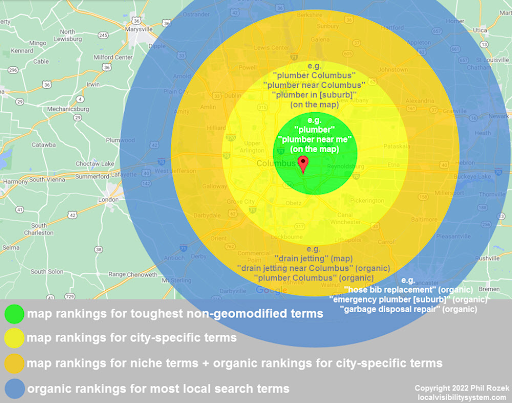The TikTok Search Revolution: How Gen Z is Transforming Online Discovery
Local Memo: A Record Number of Reviews Mention Inflation, According to Yelp
In this week’s update, learn about Yelp’s new report on consumer sentiment and business recovery; Google’s post explaining its review moderation process; a guide to UTM tagging for multi-location brands; an update on the FTC’s fight against misleading reviews; Facebook’s Valentine’s Day tips for retailers; and a radius-based ranking strategy.
A Record Number of Reviews Mention Inflation, According to Yelp
Yelp has released the results of its annual Economic Average report for 2021, claiming that the effects of inflation in Q4 drove more consumers than ever to describe “inflationary experiences” when writing reviews on the platform. Noting that many businesses have been forced to raise prices due to increased costs for labor and supplies, Yelp’s study tracked inflation-related phrases like “higher prices” and “more expensive,” finding that their incidence was greater in 2021 than in any year since 2015, tracking closely with actual inflation rates as shown in the chart below.
Though consumers seem highly aware of inflation, they also exhibit signs of increased spending. Searches for the highest-priced restaurants on the platform (designated by “$$$$”) are up 56% according to the report, and searches for the least-expensive restaurants declined in the same period. New business openings increased 8% in 2021, and consumers exhibited a desire to return to travel and events, with Thanksgiving setting a record for pandemic travel. Consumers are opting to rent equipment and services for private celebrations as opposed to attending public events.
More consumers dined out in 2021 than in 2020, but food delivery increased as well at a rate of 7%, with delivery requests in 2021 coming in 107% higher than before the pandemic.

Courtesy of Yelp
Google Explains Review Moderation
From time to time, Google publishes information about its efforts to maintain the integrity of its reviews and the steps it takes to combat fake reviews of various kinds. This PR strategy is clearly intended to counteract the opinion, shared by many local SEOs, that fake reviews are rampant on the platform and that Google hasn’t taken the issue seriously. Now that the FTC has trained its sights on review fraud (see update below), Google, the largest repository of local business reviews on the planet, has an even greater incentive to present an image of vigilance.
So the blog post published by the company last week about its process for combatting review fraud comes as no surprise, though it largely reiterates information the company has shared in the past. In brief, Google’s first line of defense for combating reviews that violate its policies is to utilize machine learning to automatically flag instances where a review contains offensive content, is off topic, comes from a suspicious account, or is part of an unusual pattern (such as a sudden influx of very positive or very negative reviews for one business). Human moderators are tasked with deciding whether reviews tagged by users for policy violations should be removed from publication, and also work proactively to implement protections for businesses that may be affected by a controversial event, such as an election.
The post includes a new video that describes the value of reviews and Google’s process for maintaining their integrity.
Courtesy of Google
A Guide to UTM Tagging for Multi-Location Businesses
In a post that has attracted some fans already within the SOCi client success team, Claire Carlisle covers best practices for implementing UTM tags if you’re a multi-location business. If you’re unfamiliar, UTM stands for Urchin Tracking Module and is a set of parameters you can add to external links in order to better track the source of your web traffic. So for instance, many companies use UTM tags in the local landing page URLs published to their Google Business Profiles, those tags designed to identify GBP within Google Analytics as the source of traffic to the business website.
Carlile points out that Google tracks website clicks within GBP but only for the main business website; UTMs are the only way to track visits to secondary URLs such as appointment links and ordering links. UTM tags can also help keep track of traffic from the CTA buttons in Google Posts and product listings. Tags may not work if the URL is a redirect.
Carlile’s guide contains extensive tips on the proper structuring and usage of UTM tags.
Update on FTC Review Fraud Actions
Mike Blumenthal has written two follow-ups to his earlier column on the recent FTC actions against Fashion Nova and various review platforms, which I covered in the last Local Memo post. One of the two is an examination of the FTC’s new guidelines for platforms that help businesses manage reviews. The FTC distinguishes in its guidelines between “open” platforms where any consumer can submit a review, and “closed” platforms that “limit collection to verified buyers or users,” focusing most of its attention on the latter. These “closed” platforms may provide tools that automate the collection of reviews, and may moderate the reviews themselves or leave that task to the business.
The FTC is primarily concerned that review platforms do not exhibit unfair bias when asking for reviews, moderating reviews, or publishing reviews. Blumenthal calls out some of the more important guidelines; for instance, the FTC advises that platforms publishing reviews should not suppress negative reviews and also should not make positive reviews appear more prominently than negative ones.
In the second followup post, Blumenthal relates that his organization Near Media sent a Freedom of Information Act request to the FTC to obtain the names of the platforms who recently received warning letters, as well as the letters themselves, which detail some of the advertised features that subjected the platforms to FTC scrutiny.
Facebook Shares Retailer Tips for Valentine’s Day
Facebook advises retailers about marketing for Valentine’s Day in a new post and infographic. The marketing tips are directed towards Marketplace sellers but can be broadly applied to any marketer who wants to tap into the search trends on the platform.
Facebook offers the following data points:
- 53% of U.S. consumers will celebrate Valentine’s Day, spending an average of $175.
- Several Valentine’s Day related searches are currently trending, many focused on unique or personalized gift ideas.
- The top five gift categories by popularity are candy, greeting cards, flowers, an evening out, and jewelry.
Facebook recommends that marketers update their product listings to reflect trending searches, use seasonally appropriate photos, and make use of incentives such as special deals and discounts to attract consumer attention.
A Radius-Based Ranking Strategy
Phil Rozek has a smart new post that offers welcome strategic advice to any businesses whose ranking reach was diminished by the recent Vicinity Update. Rozek recommends that we think of geographic ranking as being divided into a series of radii, moving outward from the nearest to the furthest with the business at the center. So for instance, a business that wants to rank for relevant terms within a 40-mile overall radius should recognize that the further one gets from the business location, the harder it is to rank for the most competitive terms. Because of this, your strategy should be to optimize for competitive terms in order to rank nearby, and niche terms in order to rank further away. Though there is no hard-and-fast method of targeting terms to a specific geographic radius, if you optimize for a range of terms from high-traffic to niche you will stand the greatest chance of achieving broad geographic reach.

Courtesy of Phil Rozek




